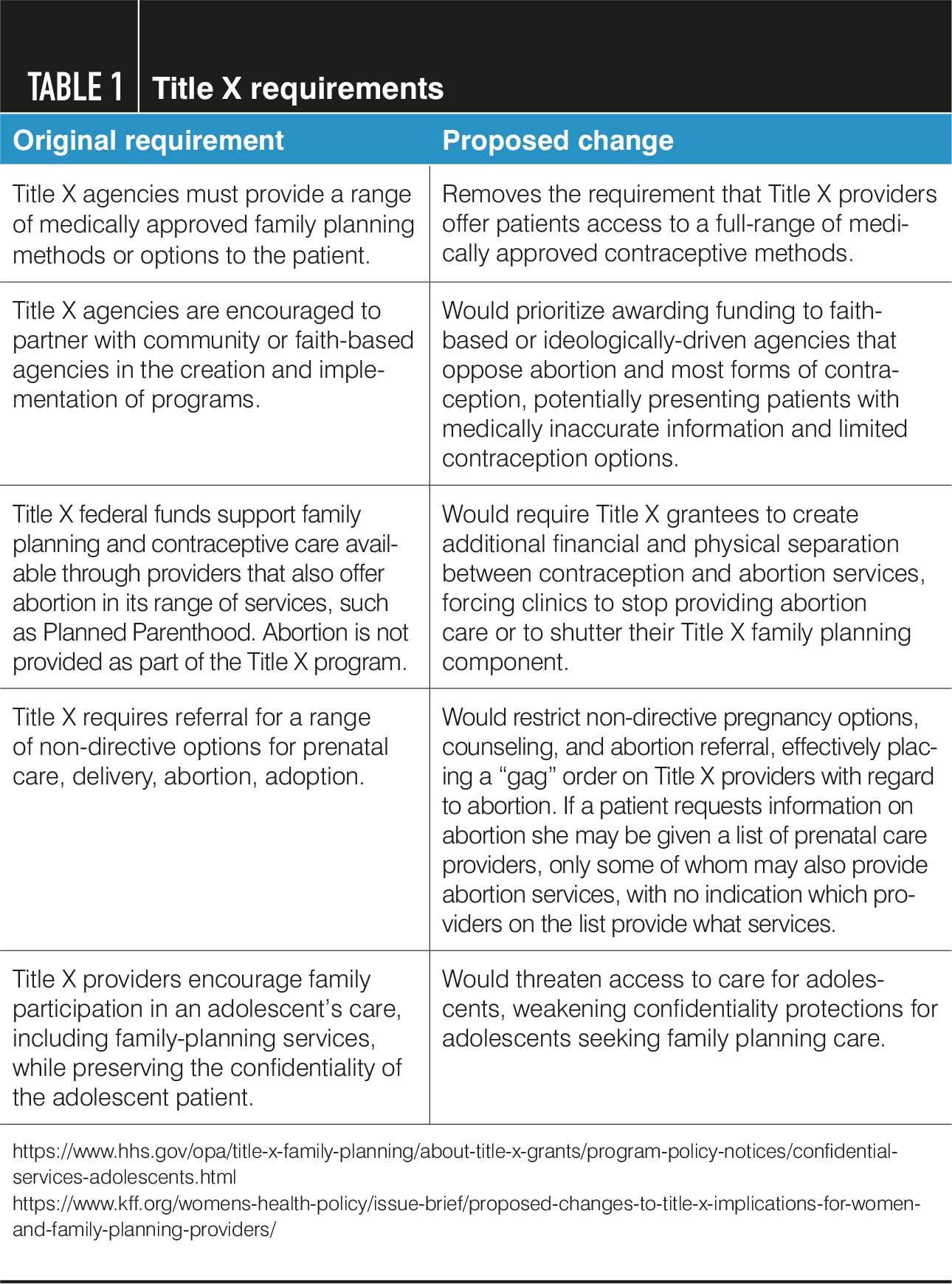Don’t mess with Title X, vital for women’s health
Proposed changes to the regulations threaten the preventive health care benefits for women and families that the program was originally created to provide.
@Hakinmhan/Shutterstock.com

As practicing obstetrician-gynecologists in a safety-net hospital, we strongly support Title X and are dismayed by a proposed federal rule change1 threatening to severely compromise it. We are privileged to serve beneficiaries of Title X, the only federal grant program that guarantees contraceptive access for low-income women, and we see the positive impact the program has on their lives and health. In New Mexico, where we practice, a large percentage of women receive services through Title X.2 With one of the country’s highest adolescent pregnancy rates and a high rate of medically complex patients, Title X allows New Mexican women of all ages to make positive health choices.
Enacted in 1970 during the Nixon administration, Title X drew bipartisan support with no dissenting votes in the Senate and only 32 dissenting votes in the House, demonstrating the overwhelming support for family planning as an integral component of preventive health care. The broad base of support came from a shared understanding that greater access to birth control would lead to fewer abortions by reducing unintended pregnancies.
Since enactment, Title X has become a critical safety net providing comprehensive contraceptive services to underserved women. Providers are required to follow quality guidelines mandating evidence-based practices, including the provision of the full range of FDA-approved methods. Research confirms that Title X centers are more likely than others to provide a broad array of contraceptives, including highly effective long-acting reversible contraceptives (LARC) and to employ protocols that facilitate the initial and continued use of contraception by patients.3

The proposed regulatory changes to Title X would severely undermine the program’s success. At risk is care that complies with the Institute of Medicine’s six dimensions of quality: care that is safe, timely, patient-centered, effective, efficient and equitable. The proposed binding rule restricts providers’ ability to offer the evidence-based contraceptive care and reproductive health counseling known to result in improved health outcomes.4 Although evidence is clear that abortion rates are lowest in regions that invest in family planning services, this ill-conceived rule change promotes less effective contraceptive methods and reduces access to abortion. We explain only a few of the many damaging components of the rule:
- The rule undermines access to comprehensive contraception through several mechanisms. One is the removal of the requirement for provision of “medically approved” family planning methods. In contrast to the current requirement, it would allow for exclusion of contraceptive methods based on grantee bias, limiting methods provided. Another is the provision of funds to faith-based entities that promote fertility awareness and abstinence. The rule change would open the door for ideologically-driven entities that oppose abortion and most forms of contraception-for example, so called “crisis pregnancy centers”-to become Title X grantees, offering medically inaccurate information and a single form of contraception, i.e., natural family planning. The rule elevates natural family planning and abstinence counseling to a program priority and excludes reference to evidence-based contraception guidelines.
- The rule creates burdensome requirements intended to block federal funds to Planned Parenthood. It requires Title X grantees to create additional financial and physical separation of contraception and abortion services. The rule targets centers that provide both Title X family planning services and non-federally funded abortion services, forcing clinics to stop providing abortion care or to shutter their Title X family planning component. In a similar change, when Texas excluded abortion providers from its family planning program in 2013, the number of contraceptive prescriptions, provision of LARC and number of women served by the program dropped dramatically.
- The rule restricts non-directive pregnancy options counseling and abortion referral: The most explicit anti-abortion components of the rule egregiously violate the patient-provider relationship and limit access to reproductive health care. Title X providers could not encourage, promote or “present” the option of abortion unless the patient had already chosen to terminate the pregnancy and explicitly requested a referral. In that case, a physician may, but is not required, to give her a list of providers, all of whom must offer prenatal care but only some of whom may also provide abortion. The physician may not tell the patient which providers on the list provide both abortion and prenatal care, even if she explicitly asks. If the patient has not made up her mind but requests information regarding abortion referral, the provider may only give her a list of providers who offer prenatal care. This “gag” component violates providers’ ethical duty to impart complete, unbiased, and accurate information and is counter to the quality-care principles of the Institute of Medicine.
- The rule undermines adolescents’ confidentiality: Under current rules, Title X providers must offer confidential services to adolescents. The proposed rule requires providers to certify that they encourage family participation in minors’ decisions to seek family-planning services, including required documentation of specific actions taken to encourage family involvement. Because this requirement would undoubtedly deter many minors from seeking care, it runs counter to our national goal of reducing the high rate of teen pregnancy and sexually transmitted infections.
In addition, the dense 31-page document outlining the proposed rule contains vague and confusing language. Struggling to understand what is and is not permissible, providers are apt to err on the side of a more conservative interpretation, lest they inadvertently violate the rule. If authorized, this rule would make effective birth control far less accessible to low income women-including women of color-and would therefore exacerbate the socioeconomic and racial health inequities tarnishing American society.
Title X has had an enormous positive impact on women’s health. Twenty percent of women in the United States who receive contraceptive services obtain them from a Title X-supported clinic. Consequently, in the past two decades Title X has averted nearly 20 million unintended pregnancies and 9 million abortions. The program has saved three tax-payer dollars for every dollar invested.5 The Centers for Disease Control and Prevention heralded family planning as one of the top 10 public health achievements of the 20thcentury. Family planning has led to improved health outcomes for infants, children, and adult women and has provided new social and economic opportunities for women.6
The comment period for the rule changes ended on July 31, 2018. The American College of Obstetricians and Gynecologists, along with 40 of its state Sections-including New Mexico ACOG-submitted formal comments to the Department of Health and Human Services detailing all these concerns on behalf of women’s health care providers. Many other leading medical organizations also lent their expertise to oppose the rule, and we’re hopeful the Administration will take heed. In the meantime, while we wait to hear the decision on final rule language, as ob/gyns, we must take our place in the vanguard, continuing to honor our human-rights charge of empowering women, families and societies through access to family planning.
Disclosures:
Disclaimer: This guest editorial does not necessarily reflect the views of all members of the editorial staff or the board of Contemporary OB/GYN.
References:
1. Compliance with Statutory Program Integrity Requirements, 83 Fed. Reg. 25502 (June 1, 2018) (to be codified at 42 CFR Part 59). Accessed at https://www.gpo.gov/fdsys/pkg/FR-2018-06-01/pdf/2018-11673.pdf.
2. The Title X Family Planning Program in New Mexico. National Family Planning and Reproductive Health Foundation. Accessed 8-19-18 at https://www.nationalfamilyplanning.org/file/impact-maps-2017/NM.pdf.
3. Mia R. Zolna & Jennifer J. Frost, Guttmacher Inst., Publicly Funded Family Planning Clinics in 2015: Patterns and Trends in Service Delivery Practices and Protocols at 30, 35 (2016). Accessed 8-19-18 at
https://www.guttmacher.org/sites/default/files/report_pdf/publicly-funded-family-planning-clinic-survey-2015_1.pdf.
4. Gavin L, Moskosky S, Carter M, et al. Providing Qualify Family Planning Services: Recommendations of CDC and the U.S. Office of Population Affairs, MMWR 2014;63(4)1-54. Accessed 8-19-18 at
https://www.cdc.gov/mmwr/pdf/rr/rr6304.pdf.
5. Title X: Three Decades of Accomplishment. The Guttmacher Report on Public Policy (2001). Accessed 8-19-18 at
https://www.guttmacher.org/sites/default/files/article_files/gr040105.pdf.
6. CDC: Achievements in Public Health, 1900-1999: Family Planning https://www.cdc.gov/mmwr/preview/mmwrhtml/mm4847a1.htm.

